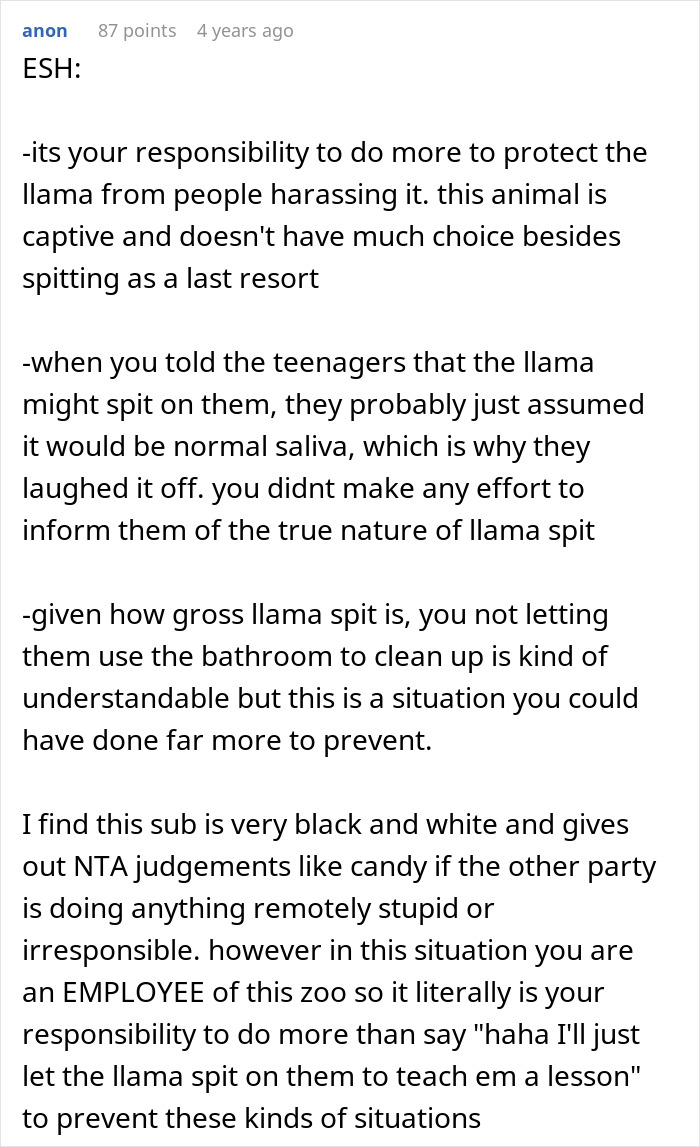I’m a huge animal lover, so I’m a big fan of just about every creature out there. Big or small, fluffy or scaly, friendly or not, I can appreciate all different types of animals. (Although, I only want to see some through the safety of a computer screen!) It is extremely important, however, that when we interact with animals we respect their boundaries and refrain from interfering with their ways of life.
A couple of teens had to learn this lesson the hard way after taking a trip to a petting zoo. Below, you’ll find the full, disgusting story that one of the zoo employees shared on Reddit, as well as a conversation with Tina Gambell from Glamping with Llamas!
This petting zoo employee gave a couple of teen visitors a heads up about what might happen if they annoyed a llama

Image credits: Abi Skipp / Flickr (not the actual photo)
But after ignoring the worker’s warnings, the teens learned the hard way why you shouldn’t mess with a llama





Image credits: Yannamelissa / Envato Elements (not the actual photo)




Image credits: oscholey1990

Image credits: solovei23 / Envato Elements (not the actual photo)
Llamas are often gentle and friendly towards humans when they’ve been properly socialized
Llamas are fascinating creatures. They’re the largest lamoid, or South American Camelid, creatures and are often used to carry things for long distances. In fact, llamas can carry up to 130 pounds for 12 hours a day, but they don’t like to be ridden by humans. They’re native to South America and have been domesticated in the region of the Andes Mountains for thousands of years. Today, however, you can find llamas all over the globe in zoos, sanctuaries and even some people’s backyards!
Llamas have thick fur to keep them warm in the winter and to protect them against bites from other animals, and they have panoramic visions thanks to their eyes being on the sides of their heads. And although these creatures may look quirky, they’re extremely speedy, as they can run up to 40 miles per hour when needed. Llamas typically stand about four feet tall at their shoulders and between five to six feet tall at their heads.
When it comes to the behavior of llamas, The Spruce Pets notes that they can be calm, gentle companions if they’ve been properly socialized from a young age. These creatures are quite curious and will often approach humans to check them out. Like most animals, it can take a while for them to become comfortable around you, but if you take the time to gain their trust and build a relationship with them, they will likely be more than happy to have you around.

Image credits: Lightitup_now / Envato Elements (not the actual photo)
But petting zoos are not the ideal environments for llamas to thrive in
To learn more about llama behavior, we reached out to Tina Gambell at Glamping with Llamas in the UK. Tina was kind enough to have a chat with Bored Panda and share that we typically don’t need to worry about spit when hanging out with llamas. “Llamas do not spit at people on the whole, if their environment and needs are met,” she explained. “Petting zoos meet neither of these essentials for having happy llamas!”
“At Glamping with Llamas, our philosophy of mutual enjoyment, ‘If it’s not fun for them, it shouldn’t be fun for us,’ shapes a unique glamping experience where human well-being and llama comfort coalesce,” Tina shared. “Our guests indulge in the tranquility of nature, complemented by the serene presence of our llamas, who enjoy a well-balanced routine of being ‘on duty’ and ‘off duty.’”
“For 23 hours a day, our llamas are ‘off duty,’ roaming freely, embodying the essence of a relaxed and stress-free lifestyle that we aim to share with our guests,” the llama expert continued. “This freedom is crucial not just for their well-being but also sets the tone for the tranquil retreat experience we offer.”
“For one hour daily, during their ‘on duty’ time, our llamas engage in meaningful interactions with guests, from educational talks about llama behavior and ancestry to close encounters facilitated by feeding sessions,” Tina noted. “This carefully structured time ensures that both llamas and guests benefit from the interaction without compromising the llamas’ comfort or natural behaviors.”
“This approach redefines luxury as a state of mutual happiness and respect, offering our guests a retreat where they can unwind and connect with nature and our llamas in a meaningful way,” she added.

Image credits: Tambako The Jaguar / Flickr (not the actual photo)
Spitting is a last resort for llamas
According to Successful Farming, spitting is a last resort act of self-defense for llamas who feel threatened. They actually want to avoid spitting just as much as others want to avoid being hit with this regurgitation because it’s not pleasant for the llamas either.
“They can’t stand the taste of it! They’ll actually sit there with their mouths hanging open and they’ll take their ears to half-mast,” Lisa Williamson, an associate professor of large animal medicine at the University of Georgia, told Successful Farming. “It’s really hysterical! So their mouth’s hanging open, there’s green stuff falling out, and they just look like somebody washed their mouth out with soap.”
And llamas will almost always give a warning before they decide to spit, such as blowing out some air and saliva, making a “pffffpth” sound, pinning their ears back and staring down their target.
We would love to hear your thoughts on this snotty situation in the comments below, pandas. Do you think these teens got what they deserved? Or do you think the employee was a bit too harsh on them? Feel free to share, and then if you’re interested in checking out another Bored Panda piece discussing petting zoo drama, look no further than right here!
Later, the employee responded to some comments and provided more details on the situation


Many readers thought that the employee was too harsh on the teens









However, some agreed that the teens got what was coming to them









